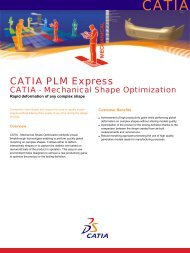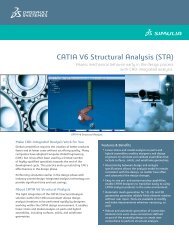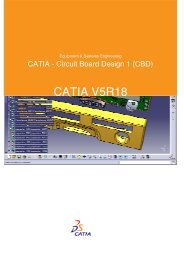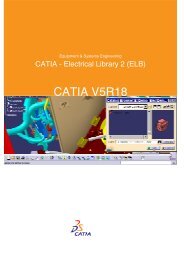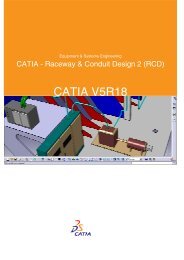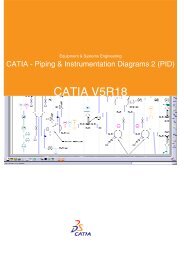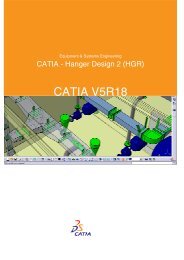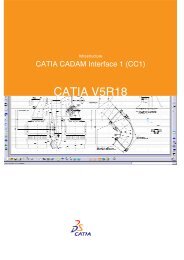Abaqus Technology Brief Automotive Brake Squeal Analysis Using ...
Abaqus Technology Brief Automotive Brake Squeal Analysis Using ...
Abaqus Technology Brief Automotive Brake Squeal Analysis Using ...
Create successful ePaper yourself
Turn your PDF publications into a flip-book with our unique Google optimized e-Paper software.
2<br />
Figure 1: Disc brake model.<br />
Step 1: Bolt pre-tension and spring interference fit<br />
analysis<br />
In the first analysis step the model is brought into its assembled<br />
state. Fastening forces are introduced in all the<br />
bolts, and a shrink-fit procedure is used to determine the<br />
assembled state of the springs that secure the brake pads<br />
in the assembly. Figure 2 displays a close-up view of a<br />
pad retention spring after the shrink-fit procedure.<br />
Figure 3: Caliper and piston, with<br />
pressure-loaded surfaces highlighted.<br />
The friction coefficient is ramped up from zero to the desired<br />
value to avoid the discontinuities and convergence<br />
problems that may arise because of the change in the<br />
friction coefficient that typically occurs when bodies in<br />
contact are moving with respect to each other.<br />
At the end of this step a steady-state braking condition is<br />
obtained. A matched mesh between the disc and the pad<br />
is not required, and a fine mesh is not required for the<br />
whole disc; rather, it is needed only in the region where<br />
the pad makes contact (see Figure 4).<br />
Figure 2: Shrink-fit of a brake pad spring.<br />
Step 2: Establish disc/brake pad contact<br />
Figure 3 displays the caliper housing and a piston. In Step<br />
2 pressure is applied on the pistons and housing in a<br />
static analysis. The contact between the pad lining and<br />
the disc is, thus, established. Step 2 allows the contact<br />
pressure distribution on the lining surface to be determined<br />
when the disc is not rotating.<br />
Step 3: Establish steady-state rotational motion<br />
In this static step a rotational velocity is imposed on the<br />
disc as a predefined field variable. This provides for the<br />
modeling of steady-state frictional sliding between two<br />
bodies that are moving with different velocities. The imposed<br />
velocity of 9.26 rad/s corresponds to braking at low<br />
velocity. In addition, the friction coefficient μ is increased<br />
to 0.4 from 0.0. The present analysis uses a constant<br />
value of μ. In general, however, the friction coefficient can<br />
be defined as a function of the relative velocity (slip rate),<br />
contact pressure, and temperature. If the friction coefficient<br />
depends on the slip rate, the rotational velocity imposed is<br />
used to determine the corresponding value of μ.<br />
Figure 4: Disc mesh, showing refinement<br />
under pad contact area.<br />
Step 4: Extraction of real eigenvalues and mode<br />
shapes<br />
The preceding steps determine the initial stresses in the<br />
model and the steady-state braking conditions. In Step 4<br />
the real eigenvalues and mode shapes of the model are<br />
extracted. In this procedure the tangential degrees of freedom<br />
at the contact nodes, at which a velocity differential is<br />
defined, are not constrained. The set of eigenmodes provides<br />
the subspace for computing complex eigenvalues in<br />
the next step.



